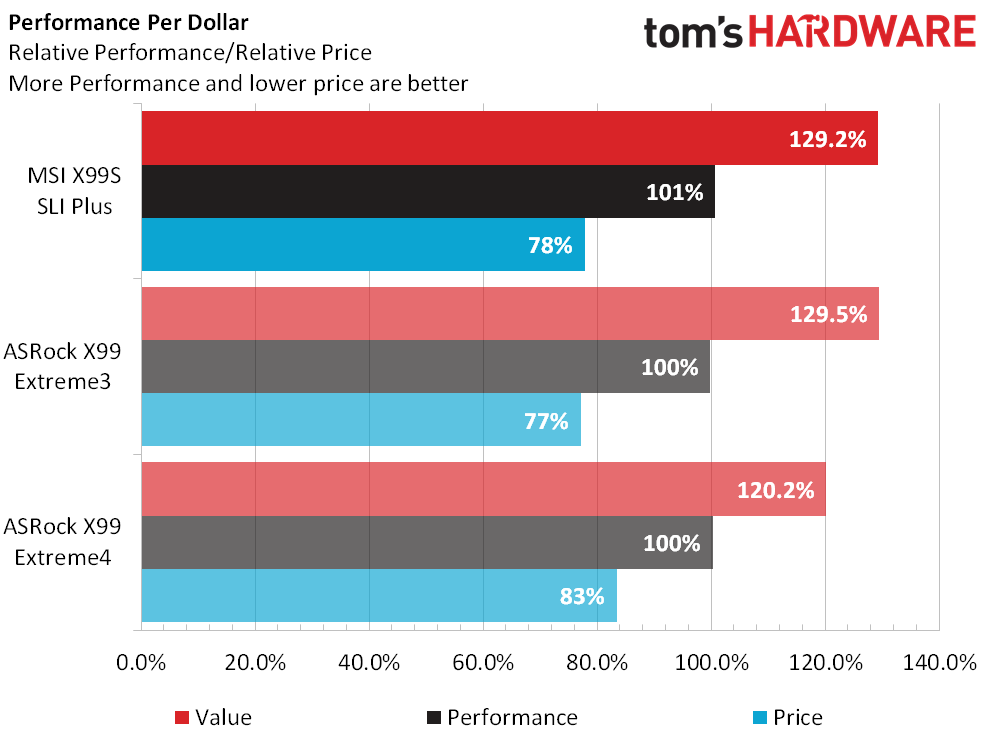MSI X99S SLI Plus Motherboard Review
Why you can trust Tom's Hardware
Value
Is the X99S SLI Plus the best solution for budget buyers? MSI thinks so, and put quite a bit of technology into this product to prove its worth. We’re still trying to figure out how one manufacturer can add four two-lane PCIe 3.0 switches to enable three-way SLI on Intel’s Core i7-5820K, while all of its competitors believe this is too costly for an entry-level X99 motherboard. As if anything X99 can be classified as entry-level.
But MSI doesn't stop with three-way SLI support. The company also adds a couple more switches to enable PCIe 3.0 x4 M.2 SSDs, or a graphics card in the fourth slot and PCIe 2.0 x2 M.2, or SATA 6Gb/s x2 M.2. That’s a lot of M.2 options. And users who don’t like M.2 can still get top SSD performance in an off-motherboard drive via SATA-Express, which is also missing from competitively-priced products. You can’t run SATA M.2 and SATA-Express, or run the M.2 slot in PCIe 2.0 x2 mode with SATA-Express, since those connections are shared, but even high-end boards with both interfaces have that restriction.
So, does this make the X99S SLI Plus a high-end board at an entry-level price? The six added-in USB 3.0 ports might have us thinking this, had we not already been blown away by all the PCIe 3.0 interface options. MSI even equips the board with twice as many DIMM slots as its closest competitor. It appears the only high-end features we don't get are a “Port 80” status code display and a secondary network interface. Those value-adds aren't missed much. We also aren't bothered by MSI's use of a previous-generation ALC892 codec where competitors have upgraded to the ALC1150.
Two final things that are missing (though not from the motherboard itself) are the second SLI bridge required to enable three-way SLI and 50MHz. Wait, what? In overclocking, the X99S SLI Plus came up 50MHz shy of most high-end boards using the same settings. Then again, so did its closest competitor. On the other hand, this is also the only moderately-priced motherboard to support our memory at data rates beyond DDR4-3200.
Performance-per-dollar appears a perfect match between the X99 Extreme3 and MSI’s X99S SLI Plus. But this chart is based on the running price of both products compared to the average of all 12 X99 motherboards we’ve tested in the past six months. If we were to instead use the temporary promotional price of $179 listed at Newegg, the X99S SLI Plus achieves a supreme value rating of 141%. Oh, and if you believe in rebate cards, Newegg even offers one for an additional $20 discount.
Get Tom's Hardware's best news and in-depth reviews, straight to your inbox.
Current page: Value
Prev Page BIOS Frequency And Voltage Settings For Overclocking Next Page Conclusion-
dor_nob I think "mainstream" is something difficult to define. There are a lot of variables to consider when selecting a motherboard for a build (a big one being price), and the selection is made based on the needs of the individual who the build is being done for. "Mainstream" for a gamer or video editor will be different than "mainstream" for a casual internet browser. I think there is no single mainstream part(s).Reply -
mapesdhs "... The -5820K's frequency is 25% slower and it has 12 of its PCIe 3.0 lanes disabled. ..."Reply
This notion of selling crippled parts is extremely annoying. It would bother me less if the CPU was designed from the ground-up to be a 28-lane part, hence less transistors, less heat & power usage, more oc headroom, etc. But selling something that's deliberately hobbled in this way is a step backwards IMO. It also makes the 4820K a rather peculiar chip, since that does have 40 lanes. There's clearly no reason for the 5820K to be restricted, it's just a lockout, most likely done with dies that have faults in the relevant silicon. Tell ya what, let's market cars with one broken wheel as 3-wheelers, because that's a good idea.
I'll be benching a 4820K soon with some 980s, anyone care to make predictions on how it'll compare to a 5820K for typical results? (3DMark11/13, etc.)
IMO the entire 5K lineup is wrong, and it's only the way it is because there's no competition. The 5820K should be a 6-core with full lanes (40, whatever), the 5930K should be 8 core with the same no. of lanes, the 5960X should be 8 or 10 core at a higher clock with a lot more lanes (64, 80, etc.), enough for full 4-way x16 with plenty to spare for M.2, priced accordingly high to make it attractive to those happy to pay oodles for something really groundbreaking, rather than the lame 3GHz lapdog we have atm which IMO is not remotely the woohaa 8-core I was hoping for.
Remember, the 3930K was an 8-core chip with 2 cores disabled, so we know Intel can easily produce affordable 8-core dies. The XEON line shows there are no technical hurdles to this (the specs of the 2687W v3 and 2697 v3 suggest the 5960X could easily have been made to run at 3.6+ base clock, they use the same lithography). Instead, it's now 2 generations past when we could have had a mid-range consumer 8-core, but we don't because Intel still doesn't need to make one.
I hope AMD can get back into the game if for no other reason than to force Intel to stop messing around and finally push the tech forward in the manner we all know it's perfectly capable of doing. Enough with the tech crippling already!
Ian.
PS. Likewise, I'm tired of the mainstream chipset still only havng 16 lanes (ie. Z97 atm), resulting in all sorts of faffing around with SLI/CF tradeoffs vs. M.2/etc. usage. It's the mainstream chipset which needs to be more like 28 lanes by now, not the bottom of the high end.
-
vertexx Crash - for 2-way SLI, can you use slots 1 and 3 if you want the spacing for better cooling? Would that be running x8/x8? I think the documentation recommends using slots 1 and 2 for dual, which has held me back from buying this board.Reply -
tical2399 ReplyCrash - for 2-way SLI, can you use slots 1 and 3 if you want the spacing for better cooling? Would that be running x8/x8? I think the documentation recommends using slots 1 and 2 for dual, which has held me back from buying this board.
Yea cause pcie 3.0 8x is really going to hurt you performance. Sarcasm aside. There is not a card in existence that going to be bottlenecked by pcie 3.0 8x. Titan x included. -
danlw Even with the tight spacing in the bottom two slots, I suppose you could run 4 cards if they had water blocks on them.Reply -
Crashman Reply
Yes, I'm trying to find these wherever I can and fix them before they get published. One chart gets copied to the same test on another spreadsheet but doesn't always get the hardware updated in the title.15818288 said:The benchmark charts for 3D gaming show a 4970K CPU, I think that's a typo.
-
RedJaron MSI has really been impressing me lately. This is a preeminent example of sensible feature tradeoffs for great performance / price.Reply -
baazing ReplyCrash - for 2-way SLI, can you use slots 1 and 3 if you want the spacing for better cooling? Would that be running x8/x8? I think the documentation recommends using slots 1 and 2 for dual, which has held me back from buying this board.
I can verify that this will work. I have this mobo with a 5820k and 2 780 ti's with nzxt kraken g10 mounted coolers which forced me to place the second card in the 3rd pcie x16 slot, as they're 3 slot coolers. I verified that both cards get pcie 3.0 x8 bandwidth through the utility in gpuz. -
ykki This board's pricing (w.r.t. its features) really confused the heck out of me. How much of a profit is MSI making with these boards?Reply

